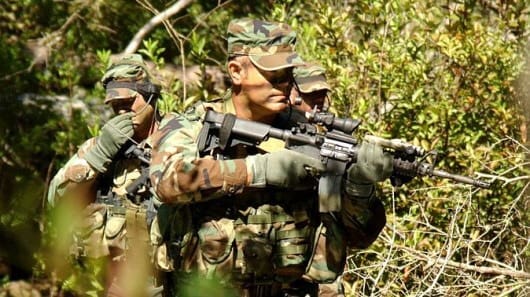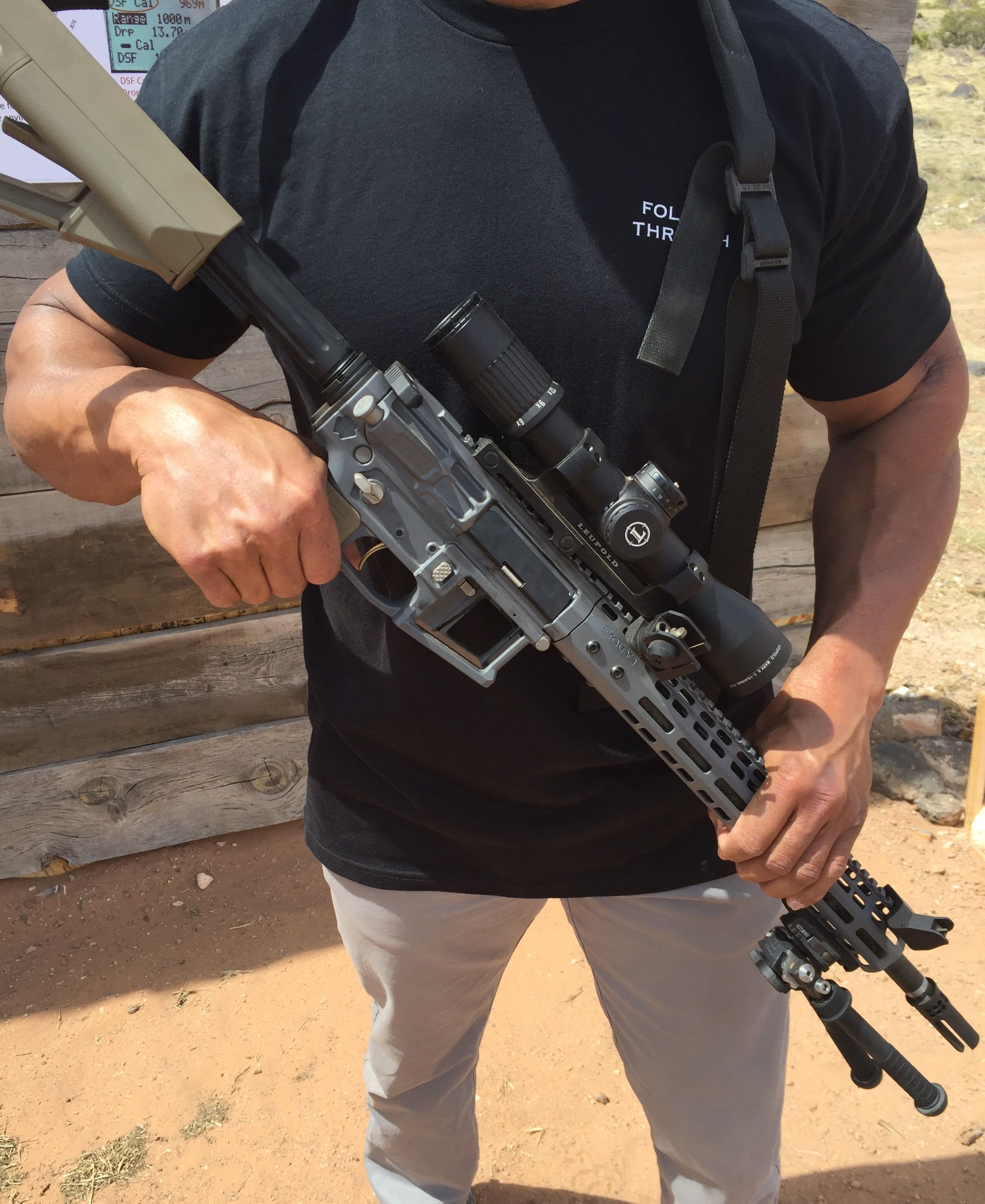This week I got to spend some time out in Utah with Buck Doyle, owner of Follow Through Consulting. Buck is very well known and respected in the Marine Reconnaissance and MARSOC communities, as well as industry. I expected to learn a lot from him and he did not disappoint.
One quick takeaway I picked up during the scoped carbine course he presented for hosts Proof Research, Erathr3, Leupold and Surefire, was this weapon grip for fast movement. I thought it was a great, quick share because anyone can easily adopt it on their own.
In the Army, I was taught to carry my rifle in a modified port arms by wrapping the fingers of my firing hand around the pistol grip with my trigger finger extended along the lower receiver above the trigger. Alternatively, I’ve seen guys extend their finger across the trigger with their fingertip resting on the magwell, as seen above. Additionally, I was taught to position my support hand under the forearm with my finger and thumb holding it securely.
Buck was taught the same thing in the Marine Corps. But the realities of combat taught him to modify this grip. Twice, he injured his trigger finger during falls in combat while rushing from one position to another. The first time he dislocated his finger and on the second, he sprained it. He said the sprain was worse because it took longer to heal. Once Buck started wrapping all of his fingers around the pistol grip, he didn’t injure it again.
I told Buck, “That makes sense for the firing hand, but what gives with the upside down grip on the support hand?” He told me that this method of carry served two functions. First, it serves the four rules of firearms safery quite well. It forces the muzzle down in a safe direction during movements. If you stumble, you won’t bring your muzzle up in the air like you would with the more tradtional port-style carry. Second, you can more naturally pull the weapon down into yourself in a full fall.
An important note. Buck adopted this technique for moving rapidly (ie running) while in combat. He fully acknowledges that you will have to transition your grip to shoot your weapon.
One of the things I find most refreshing about Buck Doyle is that there’s no BS. I talked to him about the grip and asked him what he called it. Unlike many tactical trainers, he didn’t have some fancy, trademarked name for it. For Buck, this wasn’t some theory-based technique he had dreamed up, but was based on years of actual combat as a Marine. It’s just an adaptation of a long-standing technique for use in certain circumstances. That’s the kind of thing you take away.
For those curious, the rifle is by Erathr3 with a PROOF Research barrel. The scope is Leupold and furniture by Magpul. More on all of that soon, but yes, I was hitting steel at 1164 meters with this 5.56mm package.
If you’re interested in learning more about Follow Through Consulting, visit www.followthroughconsulting.com.
Tags: Buck Doyle, EraThr3, Follow Through Consulting, Leupold, Proof Research, Surefire





That grip is also really useful for not accidentally dropping the magazine, which I’ve seen more than a few people do when they put their finger too close to the mag release as a register position.
We put our finger or fingers over the mag release when foot patrolling in populated areas so the local kids wouldn’t try running up and popping out our mags.
Would that be grounds for a buttstroke across the face?
Wow, I’d always heard everyone arguing over what finger placement was least likely to cause an ND, I don’t think I’ve ever heard someone factor in injury into the discussion. Now that you mention it, I’m surprise you don’t hear of more people messing up their fingers.
That is because it almost never happens. This is a solution for a problem no one has.
It has happened to this guy. And to me. I don’t know if you have ever tried to walk up a mountain I Afghanistan. But that shale or loose gravel at night. I cannot tell you how many times I have fallen. Plus with a ruck full of batteries and radios and part of the sniper system. You fall on the stuff and you either land hard on your rifle and bring the muzzle up towards your face. Hopeing your trigger finger doesn’t slip. Or your in a fire fight. I personally when running from cover to cover while actively engaging the enemy. Will some times forget to put my weapon on safe. Hey everyone makes mistakes. But if I trip and fell. I have weapon secured know where it’s going to go. And I know I can land on it. Personally I have broken my trigger finger but that was with a pistol on stairs. Now with a pistol. I wrap my hand around the pistol grip and extend my trigger finger up and above the trigger. This way if I do trip and fall again. I can either let the pistol slide between the 1 lst & 2nd finger. Or just let go of it. Pistol leashes are your friend. Especially the ones that auto retract. Place the retraction of close to you holster and you know right where it will be. Habit will kick in and you know where to reach for your pistol.
I wonder if he’s tried taping the trigger guard down?
Do you mean as in releasing it for mitten/gloved use, and tapping it down?
Yes, that’s it.
That’s a way
I’ve used this on many a hike…
I think the Pat McNamara football grip is better for running and blazing fast for when you want to get you some.
What is the football grip?
See following:
https://www.youtube.com/watch?v=vBy95g9zOrE
It works really well.
that has been my default for awhile, I couldn’t think of the name, I like “football grip”
Whilst I get the main meaning, I assume ‘follow through’ doesn’t mean the same colloquially in the US as the UK then?
Only when the other bloke returns fire.
We recently did a NV training gig with Buck. Great man, who knows his stuff.